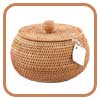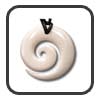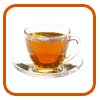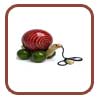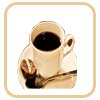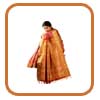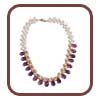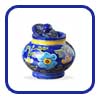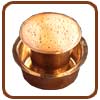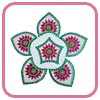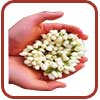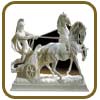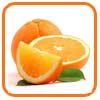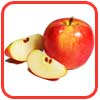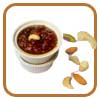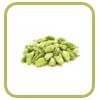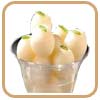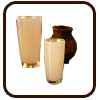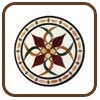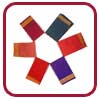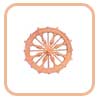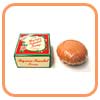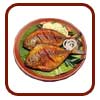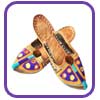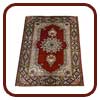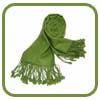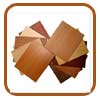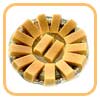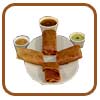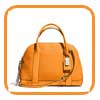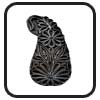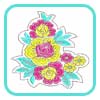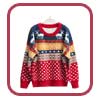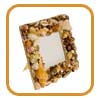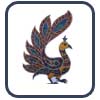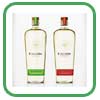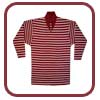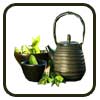 HISTORY OF PLYWOOD
HISTORY OF PLYWOOD
Thin sheets of wood veneer put together gives the structure of a wooden panel which is termed as plywood. Plywood is manufactured from medium density fiberboard called as MDF and particle board known as chipboard. The layers of plywood are pasted together with adjacent plies having their wood grain rotated relative to adjacent layers up to 90 degrees. History dates back to 1797, when a British naval engineer named Samuel Bentham applied for patent rights for machineries which are to be used for producing veneers. In his application he gave a brief description about the theory of laminating several layers of veneer with glue to form a thicker piece which is now called as plywood. Samuel Bentham did lot of inventions in the ship building industry.
 READY-MADE ARTIST BOARDS ARE MADE OF PLYWOOD
READY-MADE ARTIST BOARDS ARE MADE OF PLYWOOD
During the ancient period the veneers were available as flat sawn, rift sawn or quarter sawn which meant that the log was either cut across or along in varying angles to the grain restricted in width and length. Nearly after 50 years from the theory of Samuel Bentham, it was described by Immanuel Nobel, father of Alfred Nobel that instead of a single thick layer of wood several thin layers of wood when bonded together proved much stronger than the former.Immanuel Nobel also invented the rotary lathe for the production of laminated wood. Though there are not many records about the further set of the rotary lathe and the commercialization of plywood but still from the French dictionary of the 1870 edition there are mentions about the process of rotary lathe veneer manufacturing in its entry Deroulage. With this we can arrive at the fact that it was in the year 1860 in France the rotary lathe plywood manufacture center was established. Followed by this plywood was introduced in USA in the year 1865 which slowly led to industrial production. The first fixed or the standard sized plywood sheets were first introduced by the United States in the year 1928 which was used as a building material. Even much before it was used as a building material the plywood was used for various other purposes like as a support for easel paintings which replaced traditional canvas or cardboards. There are articles which states that in 1880 ready-made artist boards for oil painting in three-layered plywood (3-ply) were produced.
 BUILDERS USE PLYWOOD AS THE MAJOR BUILDING MATERIAL
BUILDERS USE PLYWOOD AS THE MAJOR BUILDING MATERIAL
Today almost all the builders in India use plywood as the major and common building material. Plywood has become an absolutely necessary part of construction or building material. Thin sheets of wood or veneer are pressed to give strong, adaptable, pliable featured plywood. All these characteristic features have become the prime attraction of the builders for them to be used in the construction of building. However the plywood can be graded based on the usage of different bonding agents and brand of wood used in the production. In the composite plywood material the main specialty is the cross graining which is the alteration of the grain. This feature is highly beneficiary for it decreases the likelihood of the wood to split when the edges are nailed. It also helps in the reduction and the shrinkage of the wood thereby increasing the dimensional stability. With increase in the stability the strength of the panel is the same in all directions. To reduce distortion and twist, the sheets are piled in odd numbers aiding in balancing. Because plywood is bonded with grains running against one another and with an odd number of composite parts, it is very hard to bend it perpendicular to the grain direction of the surface ply.
 TYPES OF PLYWOODS
TYPES OF PLYWOODS
-The plies or the layers are arranged at right angles to each other in those plywoods which are comparatively thin and of low quality. The next immediate better quality of plywood has their plies arranged in steps of 45 degrees which gives durability in number of axes. But however the best quality plywood is said to have plies arranged at 30 degrees in seven layers or have nine layers with two layers of 45 and 135 degrees in the sandwich. The process of manufacturing gets difficult when the step rotation is small which in turn would result in increased manufacturing cost and thereby also the retail price. Structurally the plywood panels are characterized by face veneers of a higher grade than the fundamental veneers. The core layers' primary function is to increase the panel resistance to bending by extending the separation between the outer layers because the stress is highest in this area of bending.
 PLYWOOD IS COST EFFECTIVE AND DURABLE
PLYWOOD IS COST EFFECTIVE AND DURABLE
-Thus the thick panels can stretch to a greater extent under the same weight.The maximum strain and pressure occurs in the outermost layers during bending.The stress during bending decreases from the maximum at the face layers to nearly zero at the central layer. Shear stress, by contrast, is higher in the center of the panel, and zero at the outer fibers. The more layers in a plywood the more strongly and durable it is giving a high strength- and stiffness-to-weight ratios.Plywood is very cost effective and it is graded based on the quality of the face material on a scale of A to D where the high graded is expensive than the rest. The plywood can withstand any weather be it a freezing cold or sharp sun provided it should be protected by a coating on its top with a layer of paint. Plywood has the quality of able to adapt or be adapted to many different functions or activities. Though it has many layers it is easy to be nailed and to cut when proper equipment is used.
 PLYWOODS ARE EASY TO WORK FOR IT IS OF LOW WEIGHT
PLYWOODS ARE EASY TO WORK FOR IT IS OF LOW WEIGHT 
Plywoods are easy to work with for it is relatively of low weight when compared to other wood for all it needs is basic carpentry skills. There are different types of plywood available in the market based on for what purpose or application it is used for. Medium density fiber which is commercially known as MDF is made from heat-pressed wood dust. It is very heavy when compared to the other types and is usually covered with wood veneer. The next type is the medium and high density overlay plywood which consists of a core, and then a pressed fiber material is laid over that core. This is supposed to weigh less than the MDF and also more stable than the other types. The most common type of plywood used in building construction is CDX plywood which is very common for the use on the walls and roof sheathing. Today, the market for plywood and allied products in India is estimated to be about Rs. 12,000 crores (US$ 2.50 billion) with 70% dominated by a multitude of motley players in the unorganized sector.
 IMPORTED PLYWOOD IS CHEAPER THAN DOMESTIC PLYWOOD
IMPORTED PLYWOOD IS CHEAPER THAN DOMESTIC PLYWOOD
The organized sector has been growing at between 25% and 30%. Imported plywood is cheaper than domestic Plywood due to high electricity cost, raw material cost etc. Because of this effect, most of the plywood industries have been vanishing. Two large companies are major players in this field, one by the Birla group, Mangalam Timber and Nuchem Plastics are the three major companies in the plywood industry.The production of plywood requires a huge good quality log known as peeler. The peeler is supposed to be straight with a large diameter than the one required for processing into dimensioned lumber by a saw mill. The selected log is then placed horizontally and made to rotate at its long axis. As this takes place the log is pressed by a long blade resulting in a thin layer of wood to peel like a continuous sheet of paper from a bundle. The main part of the production instrument is the nose bar which can be adjusted. As the log rotates the adjustable nose bar is made to run or press against the log so that a gap is created for veneer to pass through between the knife and the nose bar.
 WOOD IS PEELED AND ALSO SIMULTANEOUSLY COMPRESSED
WOOD IS PEELED AND ALSO SIMULTANEOUSLY COMPRESSED
-As the wood is peeled it is also simultaneously compressed by the nose bar. The vibration of the peeling knife is in check by the nose bar and aids in keeping the veneer being peeled to an accurate thickness. Thus by this process of peeling, sheets of veneer is got and then cut into the required size and dimension, after which it is allowed to dry and shrink. The plywood panel is arrived when the sheets are made to patch, grade and then glued together. After it is glued the plywood is baked in a press at a temperature set up for about 140 °C (284 °F), and at a pressure of up to 1.9 MPa which is 280 psi. Once the plywood is ready from the press they are checked for minor defects like spits or small knot holes which are then filled, re-sized, sanded or otherwise refinished, depending on the market for which the product is going to be supplied. Generally urea formaldehyde glue is the glue is used in case of indoor plywood and they are featured with less resistance for water. Whereas in case of plywood used for outdoor and marine purposes water resistant glue like phenol-formaldehyde which generally prevent delamination and to retain strength in high humidity is used.
 MAJOR CONCERN IN THE PRODUCTION PROCESS OF PLYWOOD
MAJOR CONCERN IN THE PRODUCTION PROCESS OF PLYWOOD
The major concern in the production process of plywood is the glue used because both the urea formaldehyde and phenol formaldehyde are highly carcinogenic when used in high concentrations. So most of the manufactures uses only the "E" rated adhesive which is the low formaldehyde-emitting glue system. Plywood produced to "E0" has effectively zero formaldehyde emissions. Apart from the glue factor the other major outlook in the production field is the wood resources which are a major concern of the natural resources and thereby the energy conservation.The manufacturers in the plywood production industry have several certification programs like Forest Stewardship Council (FSC), Leadership in Energy and Environmental Design (LEED), Sustainable Forestry Initiative (SFI), and Greenguard which ensures the production and construction practices are to be maintained at a certain rate or level.
 DEALERS OF PLYWOOD
DEALERS OF PLYWOOD
| 1. A ONE PLY PALACE,
17, Management Enclave, Nr. Indraprasth Bungalows, Vastrapur,
Ahmedabad-380015
(079 ) 26732929
|
| 2. ADITI WOOD INDUSTRIES,
Plot No.376, GIDC, Manjusar, Ta.Savli, Vadodara-391775
(0265 ) 2511144
|
| 3. SHREE RAM SAW MILL,
Plot No.99, Panvel Ind.Co.Op.Estate Ltd., Mumbai-Pune Rd.,
Opp.Garden Hotel, Amardham, Panvel, Dist.Raigad- 410206
(022 ) 27454630
|
| 4. Interior Point,
(020) 40014716,
Survey No 289/2, Kalpataru Housing Soceity,
Shop No 46, Near Kering Hospital,
Mahatma Phule Peth,
Pune - 41104
|
| 5. Duratec Plywoods, (080) 66491053,
No.2, Near Cb Bhandari School, 3rd Cross, Kilari Road,
Bangalore - 560053
|
 HISTORY OF PLYWOOD
HISTORY OF PLYWOOD READY-MADE ARTIST BOARDS ARE MADE OF PLYWOOD
READY-MADE ARTIST BOARDS ARE MADE OF PLYWOOD  BUILDERS USE PLYWOOD AS THE MAJOR BUILDING MATERIAL
BUILDERS USE PLYWOOD AS THE MAJOR BUILDING MATERIAL TYPES OF PLYWOODS
TYPES OF PLYWOODS 
 PLYWOOD IS COST EFFECTIVE AND DURABLE
PLYWOOD IS COST EFFECTIVE AND DURABLE PLYWOODS ARE EASY TO WORK FOR IT IS OF LOW WEIGHT
PLYWOODS ARE EASY TO WORK FOR IT IS OF LOW WEIGHT 
 IMPORTED PLYWOOD IS CHEAPER THAN DOMESTIC PLYWOOD
IMPORTED PLYWOOD IS CHEAPER THAN DOMESTIC PLYWOOD WOOD IS PEELED AND ALSO SIMULTANEOUSLY COMPRESSED
WOOD IS PEELED AND ALSO SIMULTANEOUSLY COMPRESSED MAJOR CONCERN IN THE PRODUCTION PROCESS OF PLYWOOD
MAJOR CONCERN IN THE PRODUCTION PROCESS OF PLYWOOD 
 DEALERS OF PLYWOOD
DEALERS OF PLYWOOD



